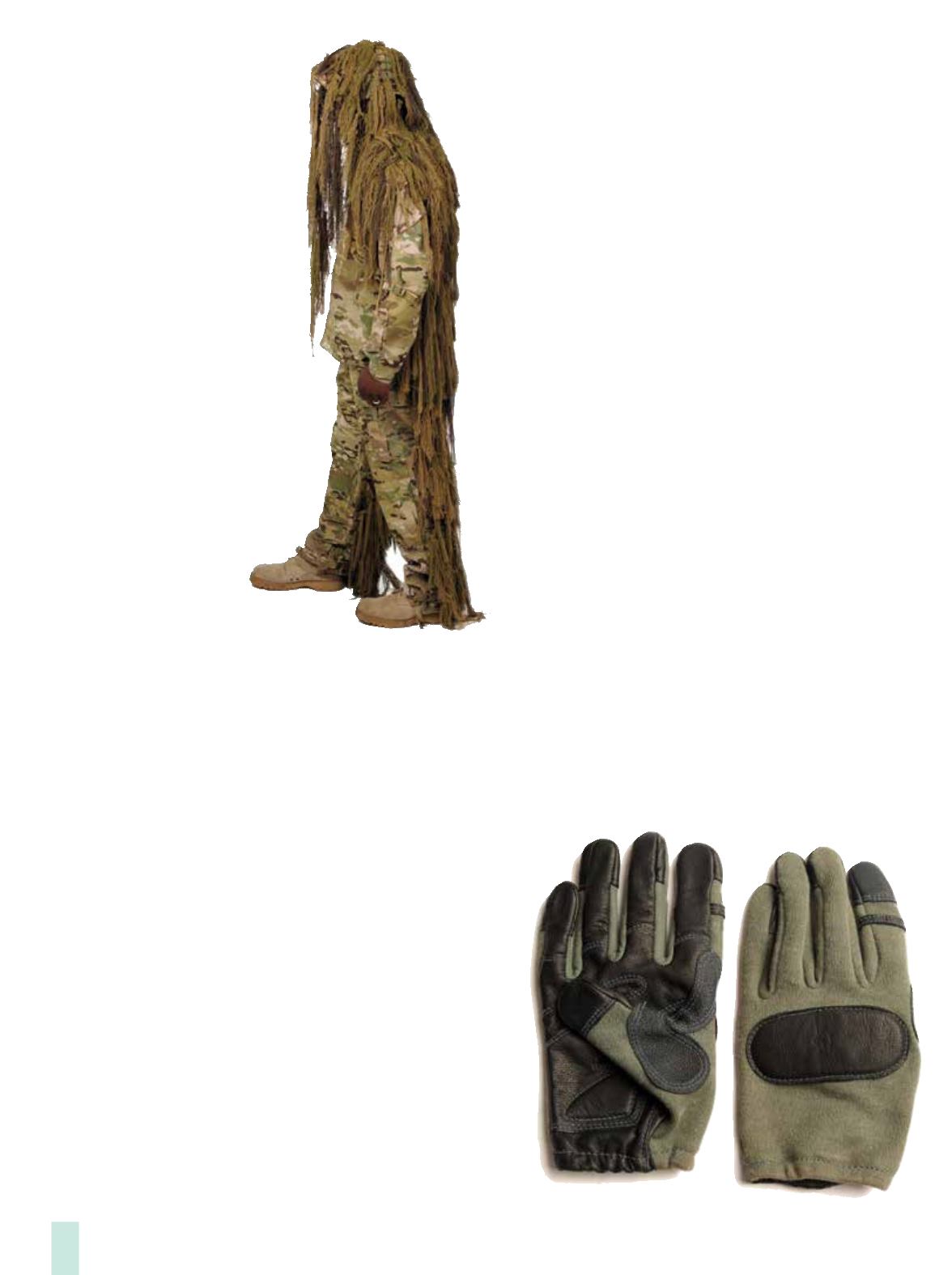

But in this modern age of ubiq-
uitous technology, more and more
material innovations have emerged
out of private industry. This is
especially true in connection with
performance-enhancing materials.
Companies such as Invista,
Polartec, DuPont, W.L. Gore and
Springfield LLC are constantly in-
troducing new textiles with rather
amazing capabilities. Meanwhile,
the U.S. Military is visiting trade
shows such as Outdoor Retailer
Summer and Winter Markets, look-
ing for the next textile innovation
that can help protect soldiers in the
field or make their lives easier in tough
environments.
The U.S. DOD, through the U.S.
Army’s Program Executive Office
Soldier organization, is responsible for
developing and procuring soldier gear
and equipment. This group, which is
commonly known as PEO Soldier,
vets most of the textiles
used by the U.S. Army for
uniforms and body armor,
and other branches often
follow its lead.
InsideOutdoor
re-
cently met with Dr. James
Zheng, lead scientist at
PEO Solider, to discuss
his challenges and the
materials the U.S. govern-
ment is hunting down
now in its effort to protect
and support our troops. Dr. Zheng and
his team are responsible for developing
and evaluating materials for body armor
as well as soldiers’ uniforms.
INSIDEOUTDOOR:
We know there
has been a crossover between private
sector performance wear companies that
conduct R&D with regard to fibers and
fabrics and the military. Their primary
focus may be sportswear, but we know
there is a crossover application to mili-
tary apparel. Given this premise, which
new materials or material innovations
is your team looking for in military
uniforms.
DR. ZHENG:
If we talk in very gen-
eral terms, we are looking for multifunc-
tional materials for uniforms, and for
this we have a very long list of require-
ments. It’s very difficult to meet all of
these requirements using
a single type of fiber,
treatment or coating.
Currently, fabric blend,
as well as multiple
coating steps are
required to impart
the needed function-
ality. Developing
multifunctional ma-
terials is a priority
for the Army.
Flame resistance
is an important re-
quirement for specific
items. We currently
use fabric blends
containing inherently
FR fiber to provide
protection against
a broad range of
thermal threats.
We’re looking for
improved FR materi-
als that can provide
improved field
durability, strength
and comfort.
Moisture
management
and air perme-
ability are also
very impor-
tant because
they’re related
to comfort.
Other relevant
properties include water repellency and
vector protection. We currently use
a topical chemical treatment on
fabric for insect bite protection.
Some items also require anti-
microbial properties.
In addition, many items
must be launderable.
Soldiers are wearing and
washing their uniforms
daily; therefore, coatings
must be durable, such
that the fabric retains
the same properties and
performance after multiple
laundering cycles.
Our current items meet
these various requirements
but require multiple manu-
facturing processes. Ideally,
we would like to combine all
of these properties into one type of fabric
or textile. This is a current research and
development focus area. For example,
the regular Army Combat Uniform is not
flame resistant and we provide a different
uniform (for deployed soldiers) with
flame-resistant properties.
IO:
You said one is flame resistant
and one isn’t?
DR. ZHENG:
Right. Deployed
soldiers and soldiers with specific
operational specialties, such as aviators,
are issued uniforms with FR protection
due to the nature of the operational
risk; however, inherently FR materials
have lower strength and durability. The
standard duty Army Combat Uniform
is made from a nylon/cotton blend
and has a much longer service life, so
it is more economical for use in non-
deployed positions.
The FR uniform has many other
requirements including water repellency
and vector protection, so we would like
to develop a fabric that provides vector
protection, maintains other properties,
and is durable.
IO:
Is the focus on, say insects and
mosquitoes, a new initiative related to
more jungle or tropical operations?
DR. ZHENG:
Yes, but vector protec-
tion is something we have been working
on for many years. We are still working
on development of new insecticides, but
at this time the Pacific Asia region is the
specific focus. We haven’t selected a new
jungle fabric or uniform. We are
The Ghillie Suit provides soldiers with
improved protection from flame and
thermal threats as well as counter-
surveillance and multi-climate protection.
Soldiers can construct, repair and modify
Ghillie Suits to meet unique mission and
climatic requirements.
Combat Gloves
Inside
Outdoor
|
Fall
2015
26
















